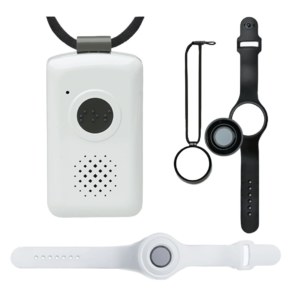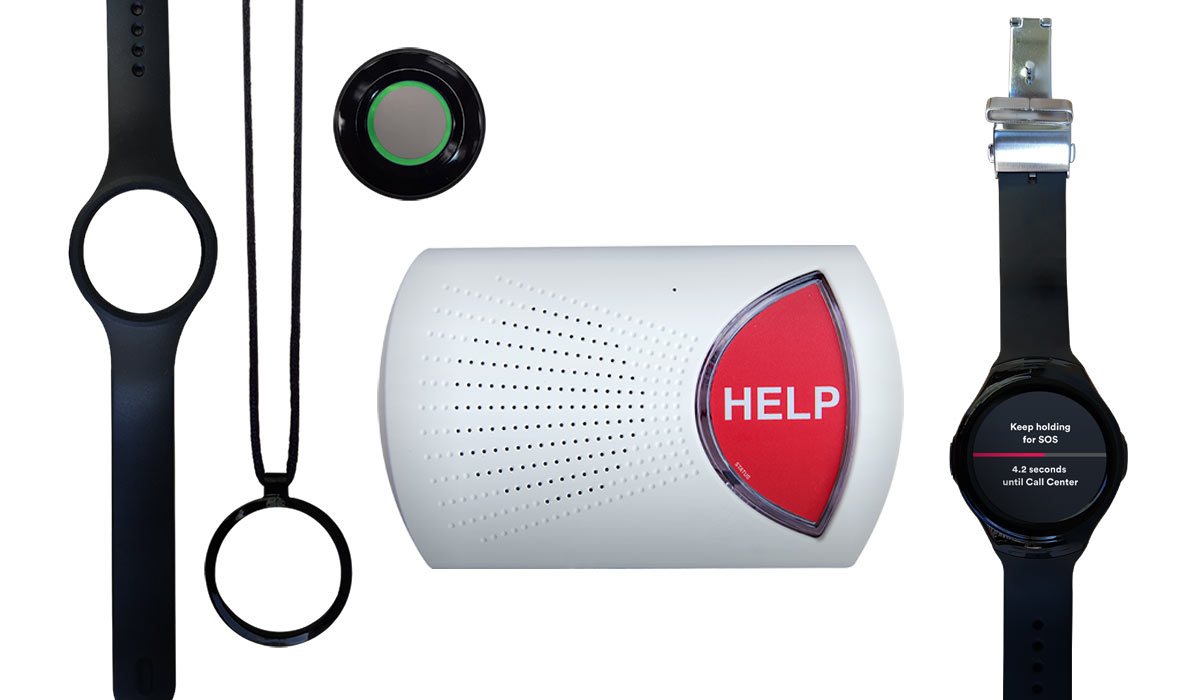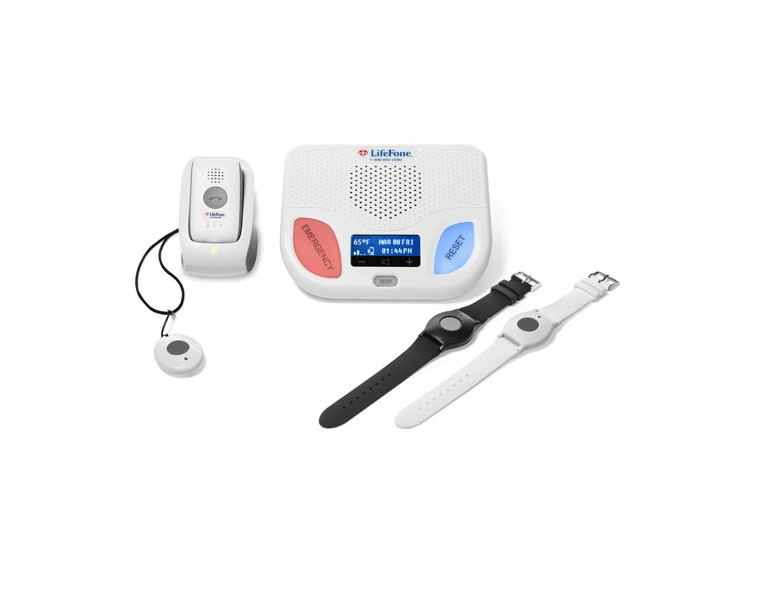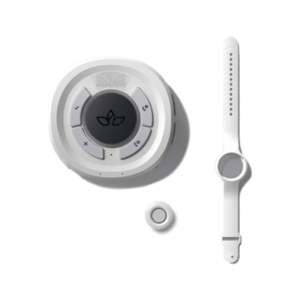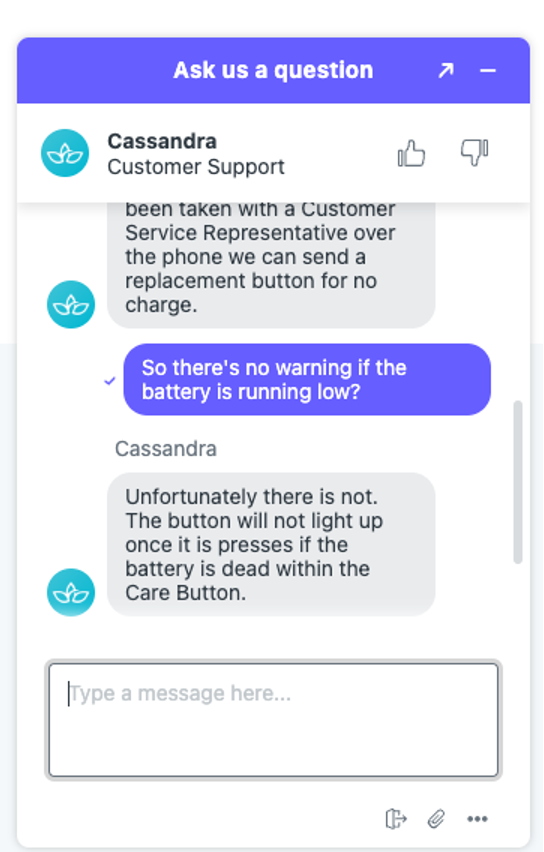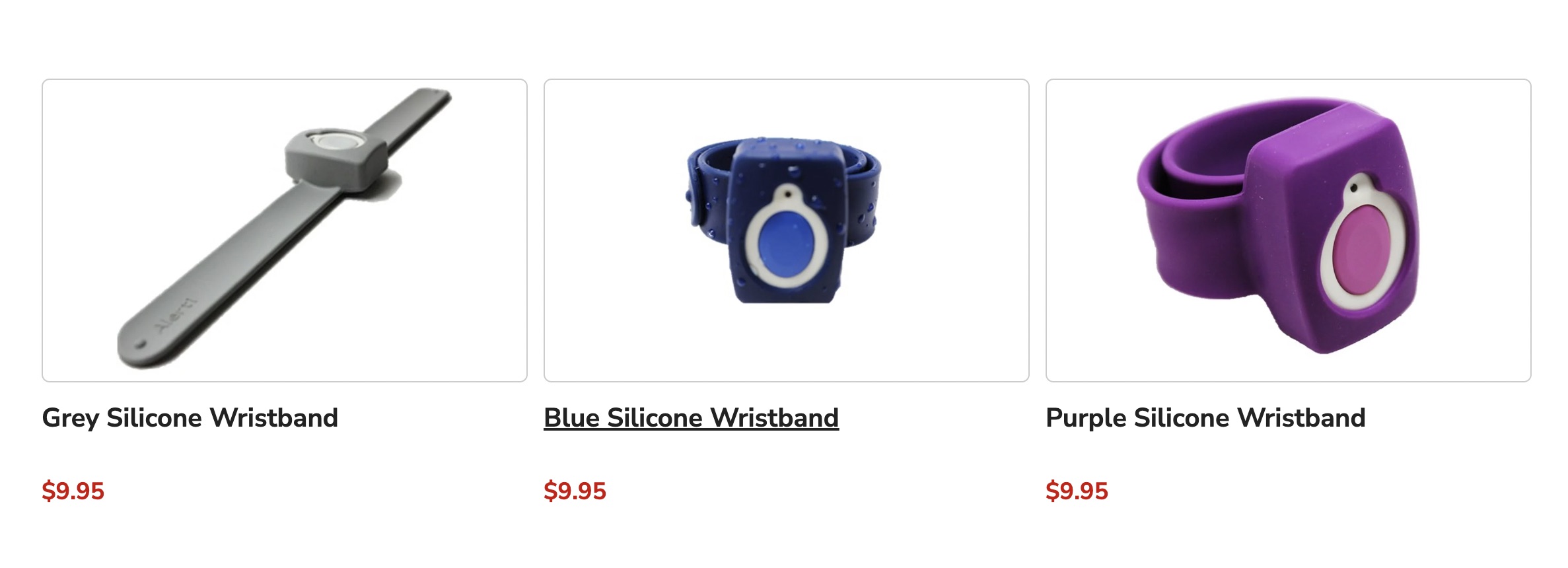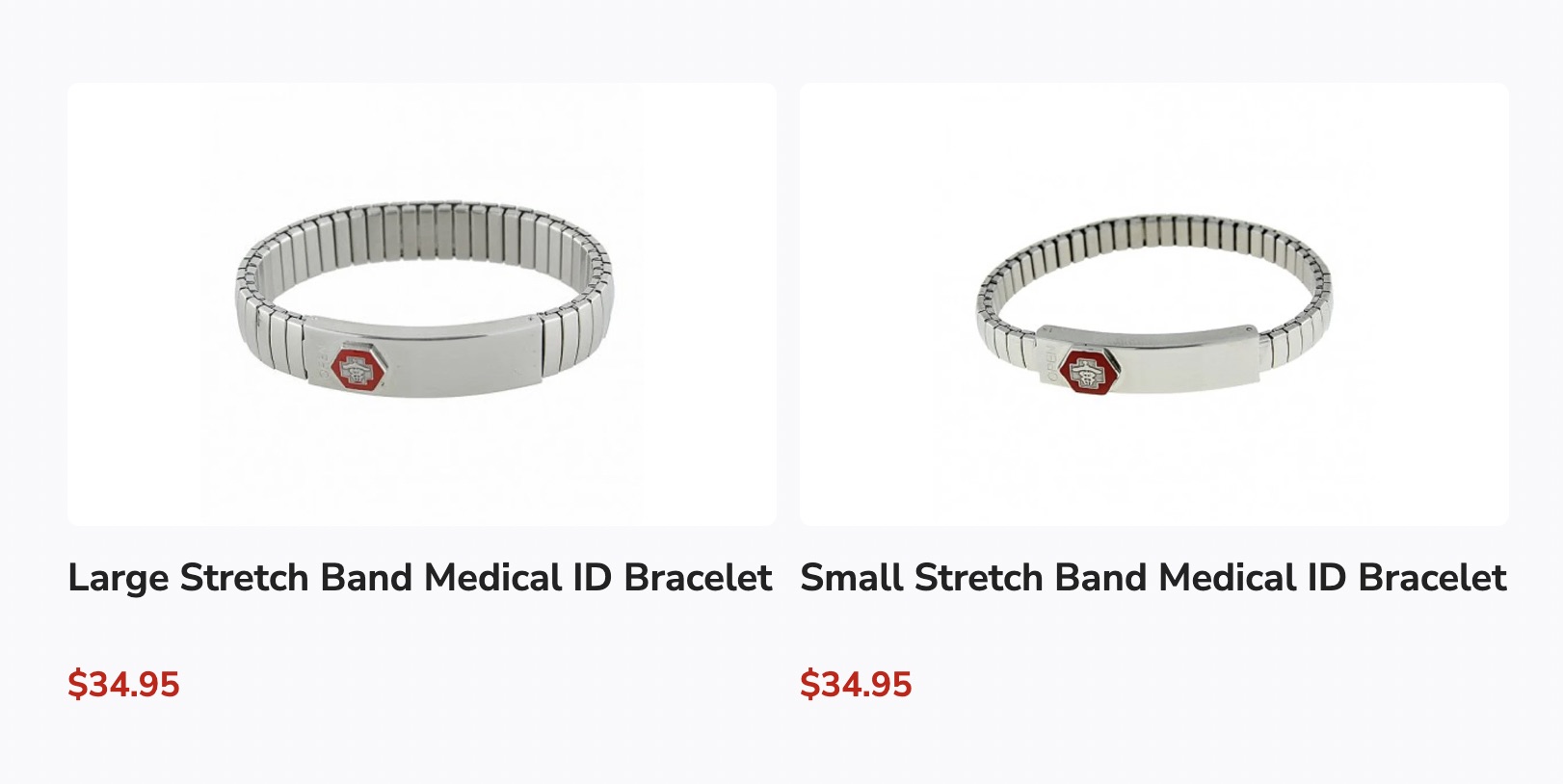Best Medical Alert Bracelets for Older Adults
Best Medical Alert Bracelets for Older Adult...
Whether you’re looking for a mobile or at-home medical alert system, most systems will include medical alert bracelets as an additional accessory. These bracelets are connected to your at-home or on-the-go medical alert system, allowing you to contact a 24/7 monitoring center to summon help during an emergency, like a fall or heart attack—from hundreds to over a thousand feet away from the main system.
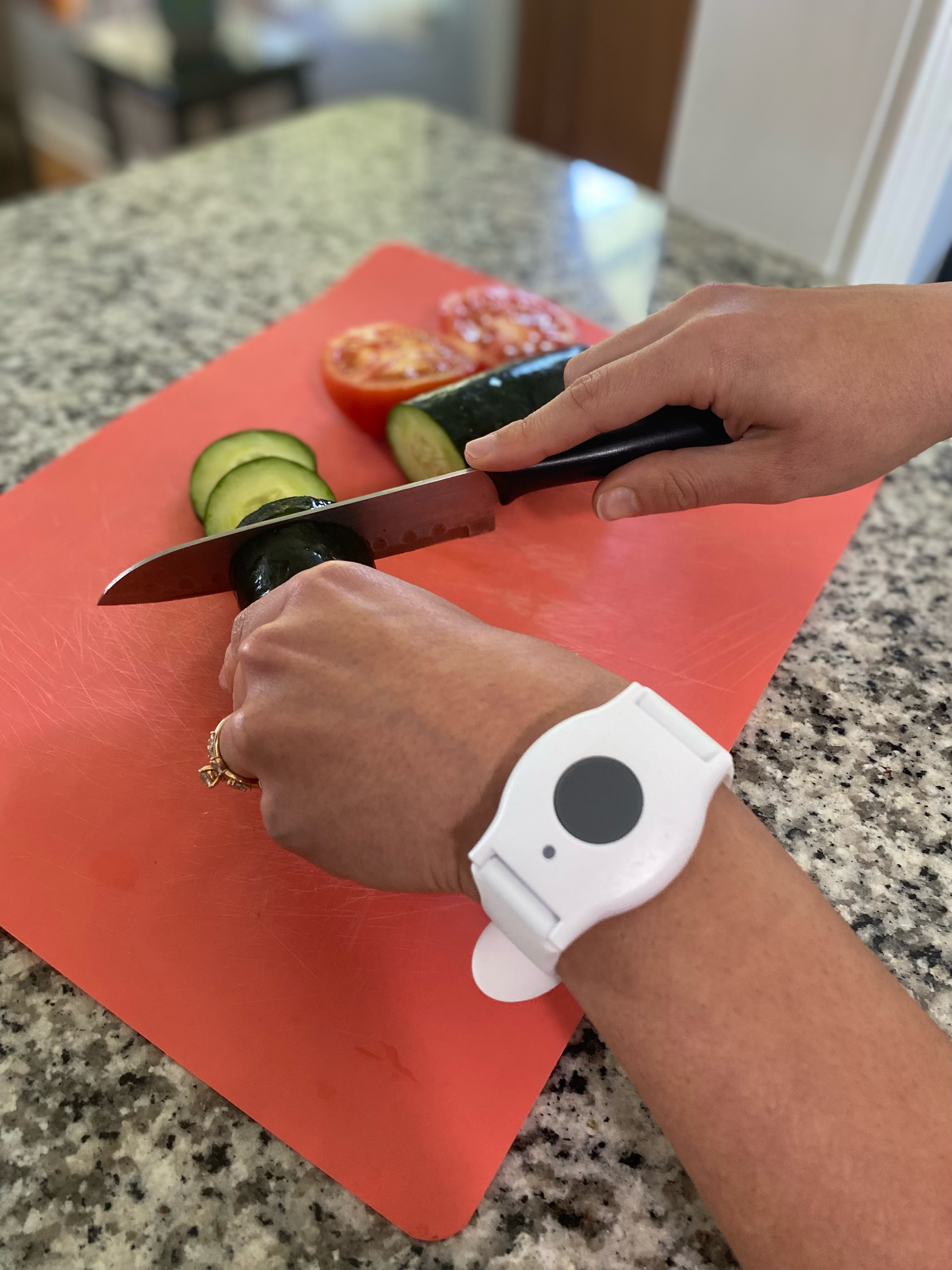
Not to be confused with medical ID bracelets, medical alert bracelets are great for older adults who want a more discreet, comfortably fitting medical alert system compared to traditional lanyards. On the other hand, medical ID bracelets function differently by displaying a wearer’s important medical information for in the event of an emergency, like the wearer’s health conditions, allergies, and current medications.
Top Medical Alert Bracelets for Older Adults
- Best for an Active Lifestyle: Medical Guardian Mobile 2.0
- Best Bracelet and Smartwatch Bundle: Bay Alarm Medical In-Home & Smartwatch Bundle
- Best Caregiver Tools and Check-In Services: LifeFone At-Home & On-the-Go
- Best for Mobility Challenges: Aloe Care Health Essentials
- Best Bracelet Design Options: Alert1 In-Home Classic Medical Alert
How We Research and Test Medical Alert Bracelets
The AgingInPlace.org team extensively researched and tested numerous medical alert systems and bracelets. From more than 1,000 hours of research, we chose the top brands that we believe offer the best medical alert bracelets. We did the following throughout our research process:
- Consulted two medical experts
- Mystery shopped the five brands
- Surveyed medical alert system users in 2021 and 2022
- Interviewed experts in the medical and aging adult fields
- Read hundreds of verified customer reviews from trusted third parties, such as Better Business Bureau (BBB) and Trustpilot
We grade each medical alert company against a 1–10 rating scale and score them according to the following categories:
- Essential features
- Product functionality
- Special features
- Customer service
- Purchasing process
Features and criteria within each of these five categories are assigned point values. The more points a company receives for each criteria, the higher they score in the overall category.
See our full explanation of our research methodology for a breakdown of criteria in each category and our scoring system.
What Are the Best Medical Alert Bracelets?
- Contract: Month-to-month after three-month commitment
- Equipment Fee: $149.95
- Activation Fee: $0
- Monthly Subscription: $44.95 per month (monthly and quarterly subscription); $41.20 per month (annual subscription)
- Cancellation Policy: Cancel any time, but no refunds before the 90-day commitment; restocking fee of up to $50.
Pros
-
Lightweight mobile device (weighs less than 2 ounces)
-
Option to add up to eight additional medical alert bracelets to your subscription
-
Standard and voice-activated wall buttons available
Cons
-
Extra bracelets cost a monthly fee instead of a one-time fee
-
No health monitoring features available
The Mobile 2.0 includes:
- Mobile 2.0 system
- Water-resistant help button
- Medical alert bracelet and lanyard option for the help button
- Mobile 2.0 charger
- Contract: None
- Equipment Fee: $159
- Activation Fee: $0
- Monthly Subscription: $49.95 per month
- Cancellation Policy: Must return within 30 days of receiving your equipment to receive a refund (minus shipping costs)
Pros
-
1,000-foot range from base station with medical alert bracelet
-
Option to add extra help button bracelets to your subscription
-
Low SOS Smartwatch equipment fee ($159) compared to competitor smartwatches
Cons
-
Must pay equipment and shipping fees to replace help button bracelet when battery is low (with the exception of paid protection plan)
-
No health monitoring features available
The In-Home & SOS Smartwatch Bundle includes:
- At-home base station (4G LTE cellular connection)
- Waterproof help button
- Medical alert bracelet and lanyard for the help button
- SOS Smartwatch
- Smartwatch charging station
- Contract: None
- Equipment Fee: $0
- Activation Fee: $0
- Monthly Subscription: $36.95 per month (annual subscription); $39.95 per month (quarterly subscription and monthly subscription)
- Cancellation Policy: 30-day money-back guarantee
Pros
-
Medical alert bracelet battery has a five-year battery life
-
Company tracks bracelet battery life and replaces it for free
-
Option to add additional help button bracelets to your subscription
Cons
-
Monthly add-on features can get expensive ($5–$39.95 per add-on, per month)
-
Inconsistent features and fall detection prices between different packages
The At-Home & On-the-Go package includes:
- At-home base station
- Mobile system
- Water-resistant help button
- Medical alert bracelet and lanyard for the help button
Editor’s Choice
What Is Editor’s Choice?
Our team of editors and writers choose a product from each article that stands out based on our extensive research of the products we review. While it may not always be the highest-scoring product in the lineup, we’ve chosen the product based on its overall value to our audience.
Why We Chose This Product:
Both the at-home and mobile system have a generous connection range from the bracelet, while two people in the same home can be protected under one monthly monitoring fee (one using the base station and the other the mobile system). With automatic monitoring and replacement for the bracelet battery, optional check-in tools, reminders, and safety monitoring, LifeFone is proactive about caring for you or your loved one.
- Contract: None
- Equipment Fee: $149.99
- Activation Fee: $0
- Monthly Subscription: $29.99 per month
- Cancellation Policy: Must return within 30 days of receiving your equipment to receive a refund.
Pros
-
Voice-activated, “hands-free” base station with medical alert bracelet
-
Base station has built-in motion, home temperature, and air quality sensors
-
Caregivers receive updates during an emergency and can call the base station with the Aloe Care app
Cons
-
Only 200-foot range from base station with medical alert bracelet
-
No low battery warning for help button
-
Additional bracelets can’t be added to subscription
The Essentials package includes:
- Smart Hub base station
- Water-resistant Care Button
- Medical alert bracelet and lanyard for the button
- Contract: None
- Equipment Fee: $0
- Activation Fee: $19.95
- Monthly Subscription: $19.95 per month (when prepaying for 10 months); $28.95 per month (when paying monthly)
- Cancellation Policy: Cancel any time and receive a prorated refund
Pros
-
Three colorful medical alert bracelet options
-
Medical ID bracelet available to purchase
-
Unique payment plan option for a free month of service
Cons
-
Only 600-foot range from base station with medical alert bracelet
-
No caregiver communication tools or health features
The In-Home Classic Medical Alert includes:
- At-home base station (landline connection)
- Showerproof help button
- Medical alert bracelet or lanyard-style option for the help button
What is a Medical Alert Bracelet?
Sometimes, “medical alert bracelets” may refer to two types of wearable devices. One is an engraved medical ID bracelet that displays the wearer’s important medical information. The second is a medical alert bracelet with a help button, which is what we referenced in this article.
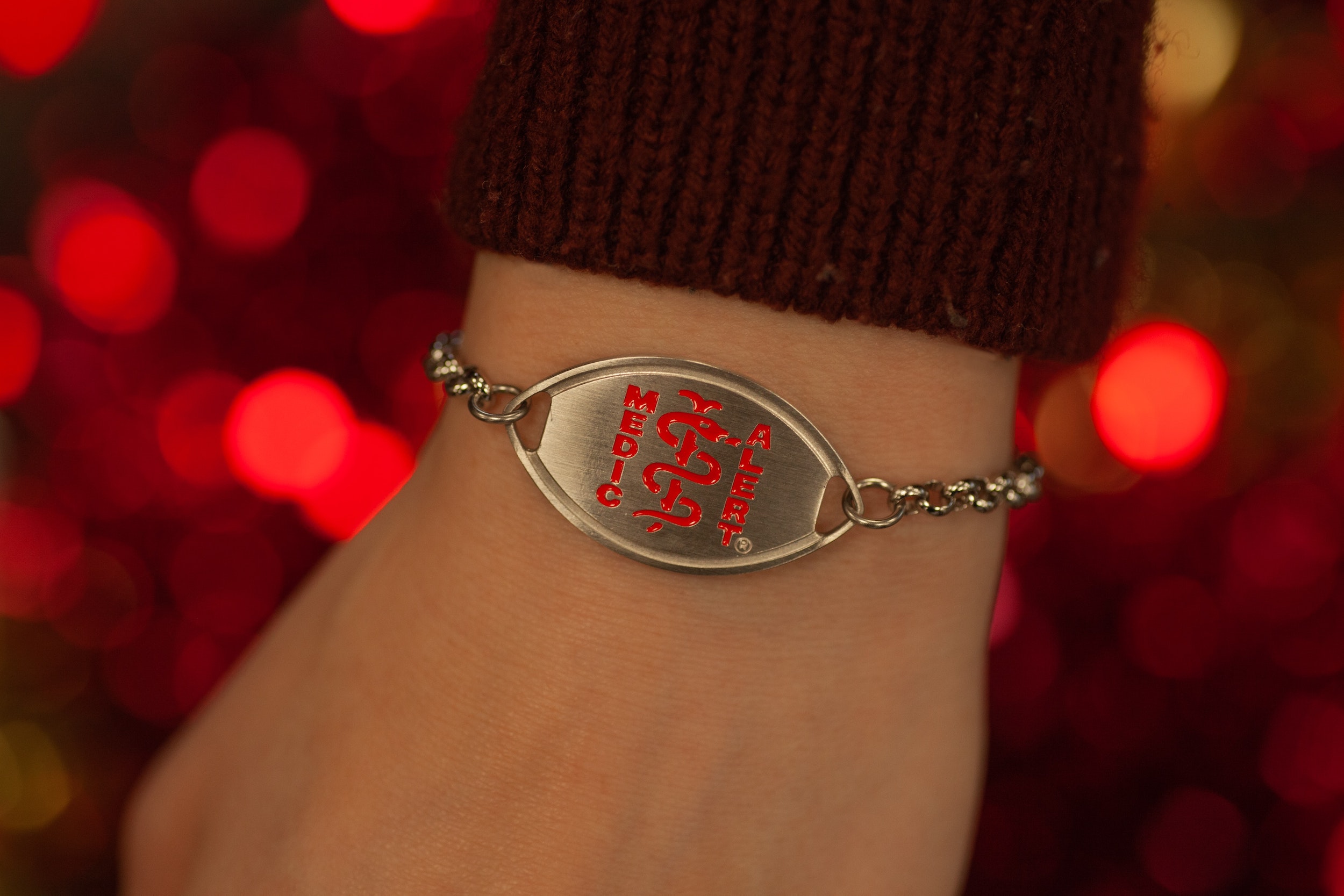
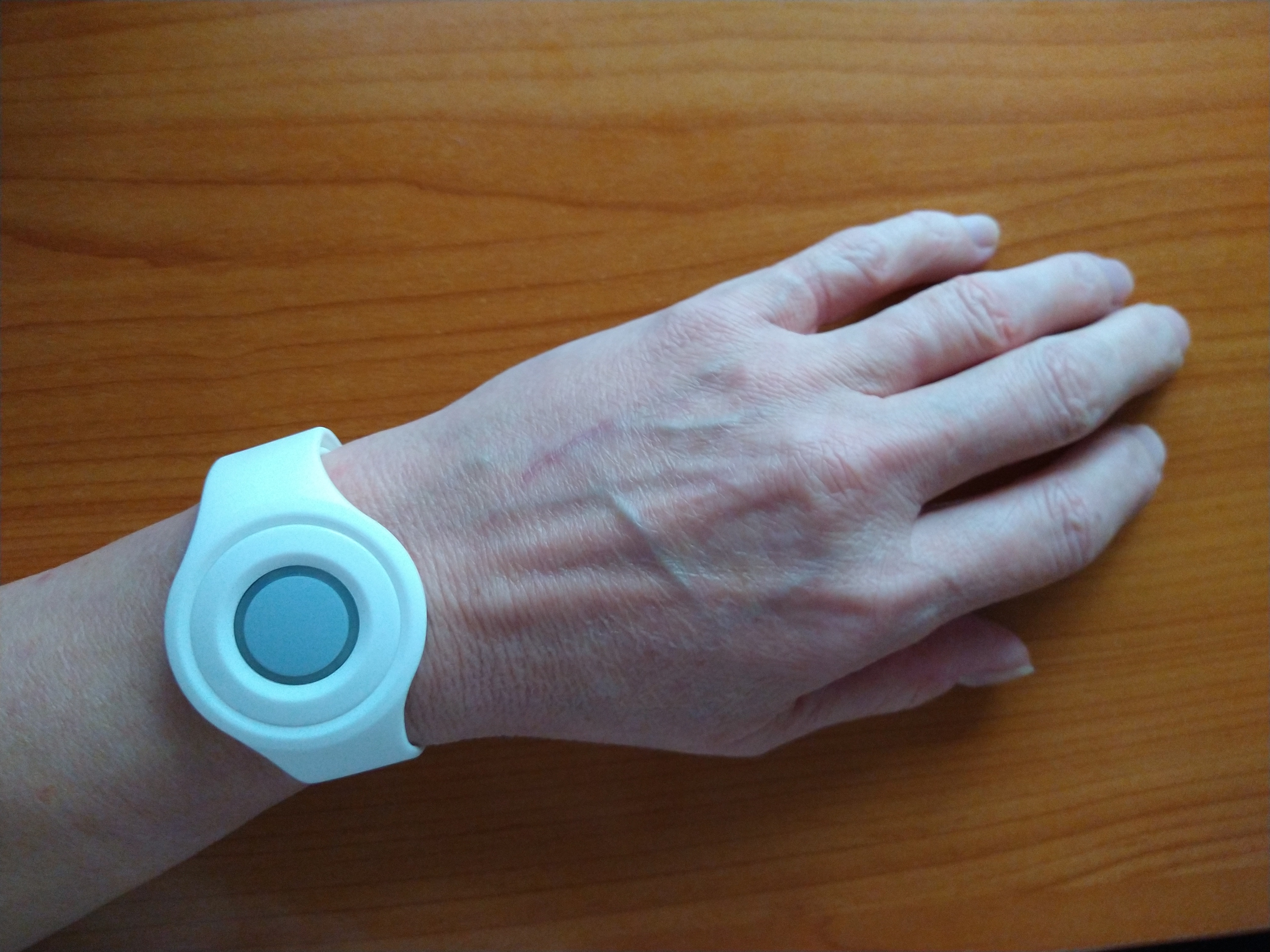
Engraved Medical ID Bracelets vs. Medical Alert Bracelets
Unlike medical alert bracelets, medical ID bracelets are not connected to a monitoring center to summon help during an emergency.
Engraved medical ID bracelets display crucial medical information to emergency responders and are especially helpful if you’re unable to communicate or unresponsive. Over 95% of paramedics look for a medical ID during an emergency, according to an American Medical ID survey.
The following type of medical information should be included on an ID bracelet:
- Allergies
- Blood type
- Chronic medical conditions
- Medications
- Medical devices like a pacemaker or implantable cardioverter defibrillator (ICD)
This isn’t an exhaustive list—what’s displayed on your medical ID bracelet will depend on your specific conditions and needs. You can also include emergency contact phone numbers.
“Medical ID alert bracelets make necessary information easily available,” said Tony Anno, a core faculty member in Walden University’s Adult-Gerontology Acute Care Nurse Practitioner Program. “This helps health care professionals provide proper care. However, emergency providers may get a false sense of security without having all the necessary information they need. For example, if a provider examines a medical alert bracelet and a blood thinner is not listed, yet one is being taken, they could make an incorrect assumption that the individual does not take blood thinners, and this could affect the care they receive.”
These bracelets are an important communication tool and should be kept up to date. You should update your bracelet for any new major medical diagnosis, medications, or if you develop a new or additional allergy. However, Norman noted that it’s often impractical to list all medications on an ID bracelet. “For the purpose of medical ID bracelets, instead of listing all the specific meds—which may not be possible—using general categories like ‘blood thinner’ or ‘heart medicine’ or ‘insulin’ (if a person has diabetes) is likely to be more helpful to health care professionals. These categories of medication, in some form or another, are often used for long periods of time while a person is still active.”
Medical Alert Bracelets With Help Buttons
A medical alert bracelet is typically a lightweight, silicone bracelet with a help button in the center. To activate it, press the button to immediately connect to a 24/7 monitoring center during an emergency. Depending on your situation, a monitoring center agent will dispatch emergency services to your location, contact loved ones, or both.
Help button bracelets are an integral part of many of the best medical alert systems we’ve reviewed and can be used with an at-home base station or mobile system that connects to the monitoring center. It’s important to note that at-home medical alert bracelets will only connect to the monitoring center when you are within range of your base station.
When paired with a mobile system, a medical alert bracelet offers more flexible protection inside or outside your home. The mobile system connects to the monitoring center from anywhere using cell service, so your range isn’t limited like it is with an at-home system. You can place your mobile medical alert device in your purse or pocket while wearing your bracelet for discreet protection.
Bracelets have a three- to five-year battery life and don’t need to be recharged. Most companies will send you a new bracelet when your battery is running low. Alert1, Aloe Care Health, and LifeFone are featured in this review and will send you a free replacement medical alert bracelet if the battery is low or completely drained.
Most medical alert bracelets don’t support fall detection since there is a high potential for false alarms. You must wear a designated fall detection lanyard or mobile system to activate fall detection.
“The device inside most medical alert devices that is used for fall detection is called an accelerometer,” explained Norman. “It (the accelerometer) is set to a certain threshold to generate an alarm when a certain velocity is reached. When the body changes position quickly, like in an instance of a fall from a standing position or similar height, that threshold is usually met, and the signal is sent to the monitoring system. The trouble with having an accelerometer on the wrist is that waving your arm at a certain speed or even certain motions like stirring a pot of something on the stove could also meet this threshold, when in fact there is not a fall emergency. Because of the general risk of false alarms, this is a big reason why fall detection is not appropriate for most medical alert bracelets. ”
Mobile systems have built-in GPS location tracking for caregivers and monitoring center agents. If you don’t know where you are, or you are unresponsive during an emergency, an agent will be able to view your location and send emergency services to you.
How Much Do Medical Alert Bracelets Cost?
The cost of your medical alert system is broken down into a purchase fee, activation fee, and monitoring fee. These costs are typically bundled to create a single, total charge when you order your medical alert system.
| Company | ||||||||||||||||||||||||||||||||||||||||||||||||||||||||||||
| Medical Guardian Mobile 2.0 | Month-by-Month Monitoring Cost | $44.95 per month | Automatic Fall Detection | $10 per month | Activation Fee | $0 | Equipment Fee | $149.95 | Shipping Fee | Free** |
|---|
| Bay Alarm Medical In-Home And SOS Smartwatch Bundle Package | Month-by-Month Monitoring Cost | $49.95 per month | Automatic Fall Detection | $10 per month | Activation Fee | $0 | Equipment Fee | $159 | Shipping Fee | Free* |
|---|
| LifeFone At-Home & On-The-Go With Optional Fall Detection | Month-by-Month Monitoring Cost | $39.95 per month | Automatic Fall Detection | $10 per month | Activation Fee | $0 | Equipment Fee | $0 | Shipping Fee | Free* |
|---|
| Aloe Care Health Essentials | Month-by-Month Monitoring Cost | $29.99 per month | Automatic Fall Detection | Activation Fee | $0 | Equipment Fee | $149.99 | Shipping Fee | Free |
|---|
| Alert1 In-Home Classic Medical Alert | Month-by-Month Monitoring Cost | $28.95 per month | Automatic Fall Detection | $10 per month | Activation Fee | $0 | Equipment Fee | $0 | Shipping Fee | Free |
|---|
*Free shipping with a quarterly or annual subscription
**Free shipping with an annual subscription
Pay close attention to all fees and costs when shopping around for your medical alert bracelet. According to a 2022 survey conducted by AgingInPlace.org, price is the number one medical alert system feature our survey respondents would like to see improved.
How to Get a Medical Alert Bracelet for Free
Medical alert bracelets are a crucial safety accessory for both users and caregivers, but equipment costs can add up. It’s difficult to get a medical alert system for free since personal emergency response systems aren’t considered “medically necessary” by most insurance providers, but there are programs available that may help pay for your medical alert system.
“PACE (program of all-inclusive care for the elderly) programs are managed long-term care programs that a person can qualify for via Medicare, Medicaid, a combination of both, and/or private pay,” Norman added. “Many PACE programs cover the cost of these devices/services and many others.”
Area Agency on Aging (AAA)
The Area Agency of Aging (AAA) is a network of nonprofit organizations serving older adults. AAA doesn’t offer free medical alert bracelets directly, but it helps you find programs that may cover medical alert system costs. AAA provides information on home and community programs in your area, offers Medicare insurance counseling, and helps with assistance program applications.
Find your local Area Agency on Aging using the online search tool.
Department of Veterans Affairs (VA)
The Department of Veterans Affairs (VA) partners with two medical alert companies to provide free medical alert systems for veterans: MedEquip Alert and Latitude Mobile Alert.
MedEquip Alert connects to a 24/7 monitoring center but doesn’t include a medical alert bracelet. Latitude Mobile Alert alerts pre-programmed contacts instead of connecting to a monitoring center during an emergency.
Medicaid
Medicaid offers two assistance programs for older adults that may help with medical alert system costs.
In some states, Medicaid’s Home and Community Based Services (HCBS) offers services designed for older adults to receive long-term care at home rather than in a nursing care facility. Medical alert systems may qualify as a service offered through HCBS. Assistance varies by state. You must apply for a waiver and be approved to receive assistance through HCBS.
Consumer Directed Services offers funding for assistive care. Medicaid does not specify that these funds be used for medical alert monitoring but leaves the decision up to the consumer on how best to use the funds. Program qualification and coverage varies by state, so speak with your insurance provider to learn.
Medicare
Some Medicare Advantage plans (Part C) may cover part or all medical alert system costs. Original Medicare (Part A and B) does not cover medical alert systems. Coverage varies by state, so speak with your insurance provider to learn about your options.
What to Look for When Shopping for the Best Medical Alert Bracelet
When shopping for a medical alert bracelet for you or your loved one, keep in mind lifestyle, personal preferences, and medical needs.
Ask yourself the following questions when comparing different medical alert bracelets:
Lifestyle
- Do you need monitoring both inside and outside the home?
- Would you like additional monitoring tools like fall detection and GPS monitoring?
- Do you want a device with an app and caregiver communication tools?
Equipment
- Do you have poor cell phone service in your area that may require an at-home landline base station?
- What is the battery life of the bracelet and/or mobile device? Does the base station have a backup battery?
Monitoring center
- What is the average response time of the monitoring center when you press the help button?
- Is the monitoring center based in the U.S.?
- Will the company penalize you for false alarms?
Return policy and warranty
- Is there a free trial period? If so, how long can you try out your equipment before sending it back for a refund?
- If you prepay an annual subscription fee but no longer need the device, will your unused months be refunded?
- Is a warranty included?
Are the Best Medical Alert Bracelets Waterproof?
Many companies assign an IP rating to bracelets and other portable medical alert equipment to indicate if they’re water-resistant or waterproof.
Water-resistant bracelets can get wet, but they can’t be fully submerged in water for long periods of time. Some companies also refer to this as showerproof. Water-resistant medical alert bracelets can typically be worn while showering, exercising, or washing dishes. Your bracelet won’t work properly if it’s worn underwater in a bathtub or swimming pool for an extended time.
Waterproof bracelets can be fully submerged in water. A Bay Alarm Medical live chat representative cautioned us against wearing a help button bracelet in a swimming pool since the chemicals may damage the device. However, wearing a waterproof bracelet submerged in the bathtub would be okay. Check with the manufacturer to find out how operational your bracelet will be when wet.
Where to Buy a Medical Alert Bracelet
You can purchase a medical alert system directly from the company of your choice on the phone or online, through online retailers like Amazon, or through the links we’ve listed above. Most company websites offer an easy online ordering process. You can also purchase your system over the phone if you’re more comfortable working with a customer service representative.
How to Order a Medical Alert Bracelet
You can order most medical alert systems online, but some companies may require you to purchase the system over the phone.
You’ll follow these general steps to order a medical alert bracelet online:
- Select an at-home, mobile, or bundle device.
- Choose a subscription payment plan (usually monthly, quarterly, or annually).
- Add optional safety features and equipment.
- Add emergency contacts and/or user profile information.
- Enter your shipping address and credit card information.
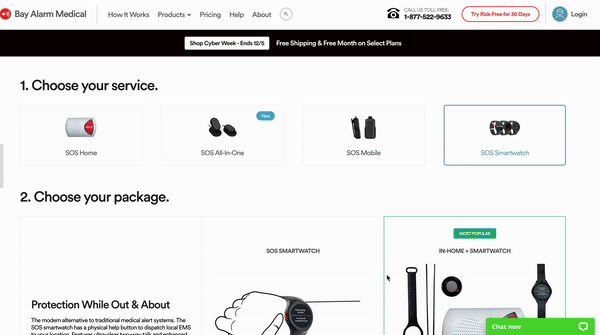
Why Should You Choose a Medical Alert Bracelet?
A medical alert bracelet provides support during an emergency, so that you can call first responders with the simple press of a button. When wearing your bracelet within the medical alert system’s range, you can move freely around your home or tuck the mobile device in your purse or pocket.
Consider the important benefits of a medical alert bracelet:
Constant connection to 24/7 monitoring center. While you can reach emergency services by dialing 911 on your cell phone, you won’t always have your phone within arm’s reach. This is especially true for more “high-risk” activities like showering or using the restroom in the middle of the night.
A more personalized emergency plan. Most medical alert companies request a list of emergency contacts to call when you alert the monitoring center. If you confirm with the monitoring agent that your emergency doesn’t require medical responders, the agent will instead notify a loved one from this list.
You can enjoy your daily routine and favorite activities knowing emergency services or a loved one are only a button away. The AgingInPlace.org survey found that over 90% of people feel more confident performing daily activities with a medical alert system.
Bottom Line
While both medical alert bracelets and medical ID bracelets can be life-saving tools during a medical emergency, medical alert bracelets connect you or your loved one to emergency services at all times with a push of a button.
Help button bracelets are available with both at-home and mobile systems. The right medical alert subscription will depend on your activity level, medical needs, and personal preference. Keep this in mind when shopping around for a medical alert bracelet.
Frequently Asked Questions
-
Medical alert systems aren’t covered by Medicare Part A or B, but Medicare Advantage and other private insurance may cover some of the costs. Coverage will vary state by state, so check with your insurance provider to see if your medical alert system is covered.
Pricing is accurate as of December 22, 2022.
WRITTEN BY
MEDICALLY REVIEWED BY
Christopher is a Board-Certified Geriatric Nurse Practitioner and Holistic Nurse. As a Nurse’s Aide, Registered Nurse and now Nurse Practitioner, he has loved working with older people since 2004. He earned his Master’s Degree with Honors at Yale University, completed an Advanced Practice Nurse Fellowship in Geriatrics at New York University, and gained comprehensive experience working with people with dementia (and their families) at Upstate Medical University in Syracuse, NY.

